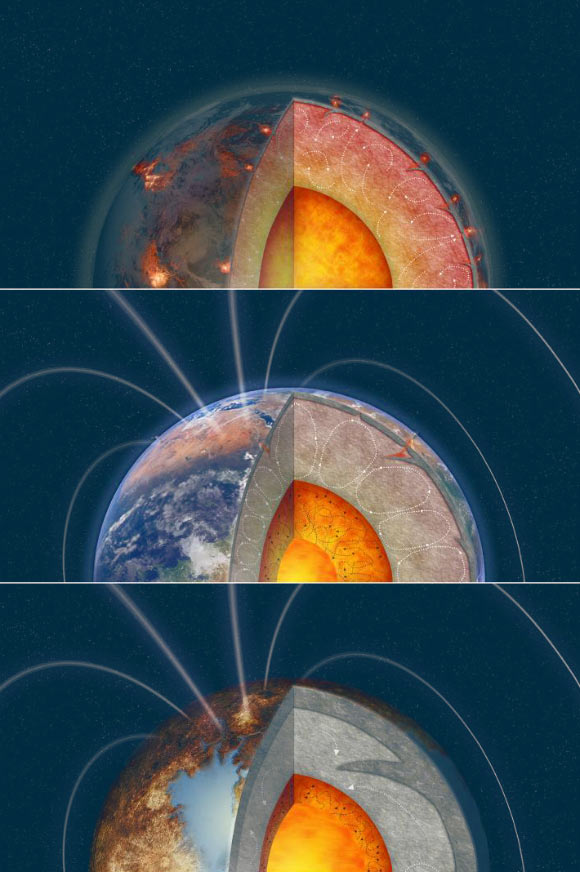The thermal evolution of rocky planets depends on the heat input from three long-lived radiogenic elements: potassium, thorium, and uranium. Concentrations of the latter two in the mantle of rocky planets are likely to vary by up to an order of magnitude between different planetary systems because these elements are produced by rare stellar processes. In a new paper published in the Astrophysical Journal Letters, a team of researchers from the University of California Santa Cruz and the University of Copenhagen discusses the effects of these variations on the thermal evolution of an Earth-size planet.

These illustrations show three versions of a rocky planet with different amounts of internal heating from radioactive elements. The middle planet is Earth-like, with plate tectonics and an internal dynamo generating a magnetic field. The top planet, with more radiogenic heating, has extreme volcanism but no dynamo or magnetic field. The bottom planet, with less radiogenic heating, is geologically ‘dead,’ with no volcanism. Image credit: Melissa Weiss.
“Convection in Earth’s molten metallic core creates an internal dynamo that generates the planet’s magnetic field,” said Professor Francis Nimmo, a researcher in the Department of Earth and Planetary Sciences at the University of California Santa Cruz.
“Earth’s supply of radioactive elements provides more than enough internal heating to generate a persistent geodynamo.”
“What we realized was that different planets accumulate different amounts of these radioactive elements that ultimately power geological activity and the magnetic field.”
“So we took a model of the Earth and dialed the amount of internal radiogenic heat production up and down to see what happens.”
What Professor Nimmo and colleagues found is that if the radiogenic heating is more than the Earth’s, the planet can’t permanently sustain a dynamo, as our home planet has done.
That happens because most of the thorium and uranium end up in the mantle, and too much heat in the mantle acts as an insulator, preventing the molten core from losing heat fast enough to generate the convective motions that produce the magnetic field.
With more radiogenic internal heating, the planet also has much more volcanic activity, which could produce frequent mass extinction events.
On the other hand, too little radioactive heat results in no volcanism and a geologically ‘dead’ planet.
“Just by changing this one variable, you sweep through these different scenarios, from geologically dead to Earth-like to extremely volcanic without a dynamo,” Professor Nimmo said.
“Now that we see the important implications of varying the amount of radiogenic heating, the simplified model that we used should be checked by more detailed calculations.”
The heavy elements crucial to radiogenic heating are created in the so-called r-process during mergers of neutron stars, which are extremely rare events.
“We would expect considerable variability in the amounts of these elements incorporated into stars and planets, because it depends on how close the matter that formed them was to where these rare events occurred in the Galaxy,” said Professor Joel Primack, a researcher in the Physics Department at the University of California Santa Cruz.
Astronomers can use spectroscopy to measure the abundance of different elements in stars, and the compositions of planets are expected to be similar to those of the stars they orbit.
The rare earth element europium, which is readily observed in stellar spectra, is created by the same process that makes thorium and uranium, so europium can be used as a tracer to study the variability of those elements in our Galaxy’s stars and planets.
The study authors were able use europium measurements for many stars in our Galactic neighborhood to establish a natural range of inputs to their models of radiogenic heating. The Sun’s composition is in the middle of that range.
“Many stars have half as much europium compared to magnesium as the Sun, and many stars have up to two times more than the Sun,” Professor Primack said.
“The importance and variability of radiogenic heating opens up many new questions for astrobiologists,” added Professor Natalie Batalha, a researcher at the University of California Santa Cruz who was not involved in the study.
“It’s a complex story, because both extremes have implications for habitability. You need enough radiogenic heating to sustain plate tectonics but not so much that you shut down the magnetic dynamo.”
“Ultimately, we’re looking for the most likely abodes of life. The abundance of uranium and thorium appear to be key factors, possibly even another dimension for defining a Goldilocks planet.”
“Using europium measurements of their stars to identify planetary systems with different amounts of radiogenic elements, astronomers can start looking for differences between the planets in those systems, especially once the James Webb Space Telescope is deployed,” Professor Nimmo said.
“This telescope will be a powerful tool for the characterization of exoplanet atmospheres.”
_____
Francis Nimmo et al. 2020. Radiogenic Heating and Its Influence on Rocky Planet Dynamos and Habitability. ApJL 903, L37; doi: 10.3847/2041-8213/abc251
This article is based on a press-release provided by the University of California Santa Cruz.







